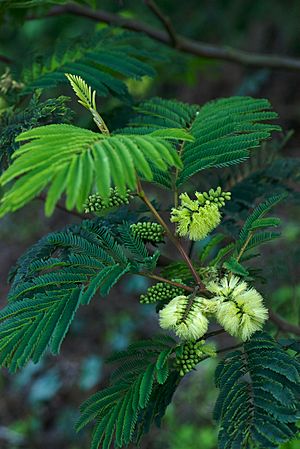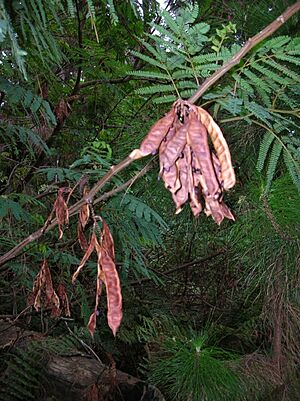Paraserianthes lophantha facts for kids
Quick facts for kids Paraserianthes lophantha |
|
|---|---|
 |
|
| Scientific classification | |
| Kingdom: | |
| (unranked): | |
| (unranked): | |
| (unranked): | |
| Order: | |
| Family: | |
| Subfamily: | |
| (unranked): | |
| Genus: |
Paraserianthes
|
| Species: |
P. lophantha
|
| Binomial name | |
| Paraserianthes lophantha (Willd.) I.C.Nielsen
|
|
| Synonyms | |
|
Albizia lophantha |
|
Paraserianthes lophantha, often called Albizia, Cape Wattle, or Crested Wattle, is a quick-growing plant. It's a type of wattle tree that has creamy-yellow flowers shaped like a bottlebrush. This small tree usually grows up to 5 meters (about 16 feet) tall. You can find it naturally along the southwest coast of Western Australia, from Fremantle down to King George Sound.
This plant was first spread outside its natural home by Baron Ferdinand von Mueller. He gave seeds of P. lophantha to early explorers. He thought that if they planted the seeds at their campsites, the trees would grow and show the routes they traveled.
However, in some parts of Australia where it isn't native, and in places like New Zealand, South Africa, the Canary Islands, and Chile, it's seen as a weed. This means it can grow very fast and sometimes take over areas, making it harder for local plants to thrive.
About the Cape Wattle
The Cape Wattle is known for its fast growth. It can quickly become a small tree, reaching about 5 meters in height. Its flowers are a creamy-yellow color and look a bit like a bottlebrush. These flowers make the tree quite noticeable.
It grows naturally in a specific part of Western Australia. This area is along the southwest coast, stretching from the city of Fremantle to a place called King George Sound. This is its original home.
How it Spread
A long time ago, in 1806, a scientist named Willdenow first described this plant. Later, in 1983, other scientists moved it into a different plant group, the Paraserianthes genus.
The plant was spread to new areas by a person named Baron Ferdinand von Mueller. He was a botanist, someone who studies plants. He believed these trees could help explorers. He gave them seeds to plant at their campsites. The idea was that the growing trees would mark the paths they took.
Why it's Sometimes a Weed
While the Cape Wattle is native to some parts of Australia, it has been introduced to many other places. When a plant grows outside its natural area and spreads quickly, it can become a problem. This is why it's called a "weed" in places like New Zealand and South Africa.
- It can grow very fast.
- It might take up space and resources that native plants need.
- It can change the natural environment in those areas.
See also
 In Spanish: Paraserianthes lophantha para niños
In Spanish: Paraserianthes lophantha para niños



